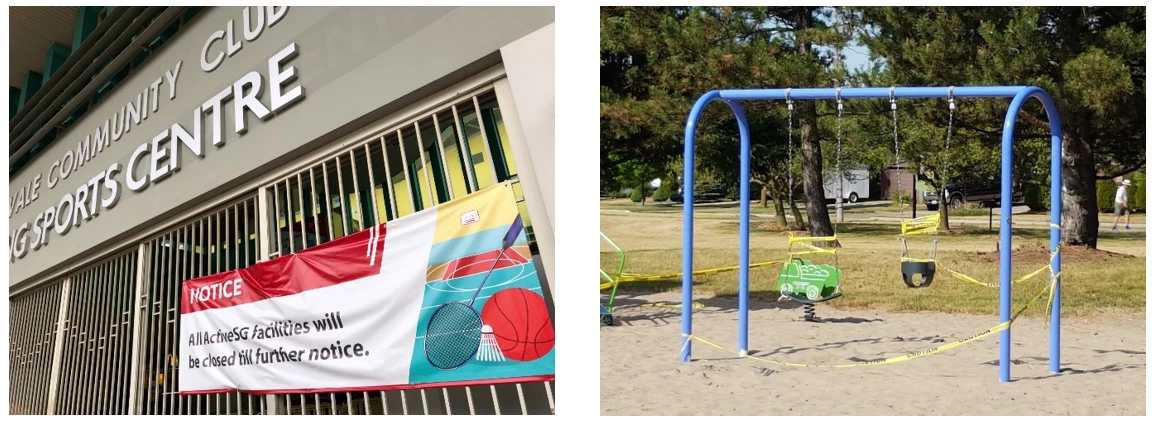 Temporary closure of a community center and public sports facility in Singapore
Temporary closure of a community center and public sports facility in Singapore
Real estate is at the center of our daily lives: homes and offices are some of the places where we live, work, and play. The same is true for governments. Public real estate assets—from community clinics to data centers—enable the delivery of important public services.
The impact of the COVID-19 pandemic on public assets is on full display. Emergency quarantine facilities have been set up in hotels, schools are now emergency food distribution centers, and new temporary structures have been built for use as overflow hospitals.
Government responses so far have largely focused on two urgent priorities: public health and supply chain continuity for essential government operations and emergency services. But COVID-19 may be with us for years, so governments should also consider the long-range impacts of the pandemic, and how they might change asset portfolios.
Government asset portfolios are diverse and will require differentiated management strategies. For example, facilities that house critical operations and essential services such as data centers, emergency operations centers, and hospitals must operate all day and year-round, whereas public schools and courthouses can be temporarily closed.
More likely than not, some services and programs may change permanently in a post-pandemic world. For example, could schools be reimagined with e-learning? Could courthouses conduct hearings virtually and effectively? Can technology streamline contact tracing in public places? It is unlikely digital solutions will eliminate the need for physical assets but they may change how assets are used and equipped, or where they are located.
These and other changes will impact long-term planning and capital allocations to ensure the right facilities are in the right place. These considerations will complicate longstanding public asset challenges, such as the need to address inefficient, poorly maintained, and expensive public buildings. If done right, the result could be reimagined and more effective public portfolios. Perhaps this is the hidden opportunity in the pandemic.
Here are three asset types that may see significant changes going forward:
- Institutional residential facilities. Residential facilities that house people in close living quarters such as long-term care homes, prisons, and homeless shelters have become hotspots. Overcrowding and sanitation have put a spotlight on immediate and short-term improvements, as well as a more holistic rethinking of programs and budgets to support these needs going forward.
- Public facilities. Many cities have restricted access or temporarily shut down public buildings. This has led governments to rethink service provision, leveraging remote and digital tools for reducing physical contact. How existing facilities are sustainably operated and managed during their lifecycle may need to be re-evaluated. Some facilities may require physical modifications or renovations, for example, air quality improvements including filtration in schools or offices.
- Public spaces. Because it is challenging to control access and movement of people in public spaces, contact tracing has become critically important. Governments may also need to fundamentally rethink the role of public spaces to factor in the need for safe distancing and public hygiene. Are some types of gathering spaces, such as large public performance areas, becoming obsolete? In contrast, are exercise trails and walkable neighborhoods becoming more important? How can existing public space be reimagined, managed for safe distancing, and maintained sustainably? Certain types of public spaces such as public toilets and marketplaces (in some countries, an essential part of the urban food supply chain) are under increased scrutiny.
One of the most enduring roles of government is to enact public policy to sustain public services, create safe and healthy environments, and protect the vulnerable. Governments must first consider how regulation and policy instruments for the built environment, can be enhanced to improve public health, reduce crowding, and improve sanitation for the long-term.
Second, they must also reimagine how services can be effectively and safely provided, through innovative means such as the use of technology, or the creative adaptation of public buildings that provide new and existing services more effectively.
Last, governments must quickly re-evaluate the financial sustainability of their real estate asset portfolios and their life cycle costs with long-term strategies to respond to potential increases in capital and operating expenses, an expanded or different role in some cases, and declining municipal revenues from the impact of COVID-19 on the economy.
This balancing act—addressing the burdens of increased health and safety measures while overcoming limited fiscal resources to deliver improved public services—will be a big challenge for many governments. However, this is also an opportunity to completely reimagine public real estate assets for better health and service delivery outcomes in a post-COVID-19 world.
Related links:
- Subscribe to our Sustainable Cities newsletter
- Follow @WBG_Cities on Twitter






Join the Conversation